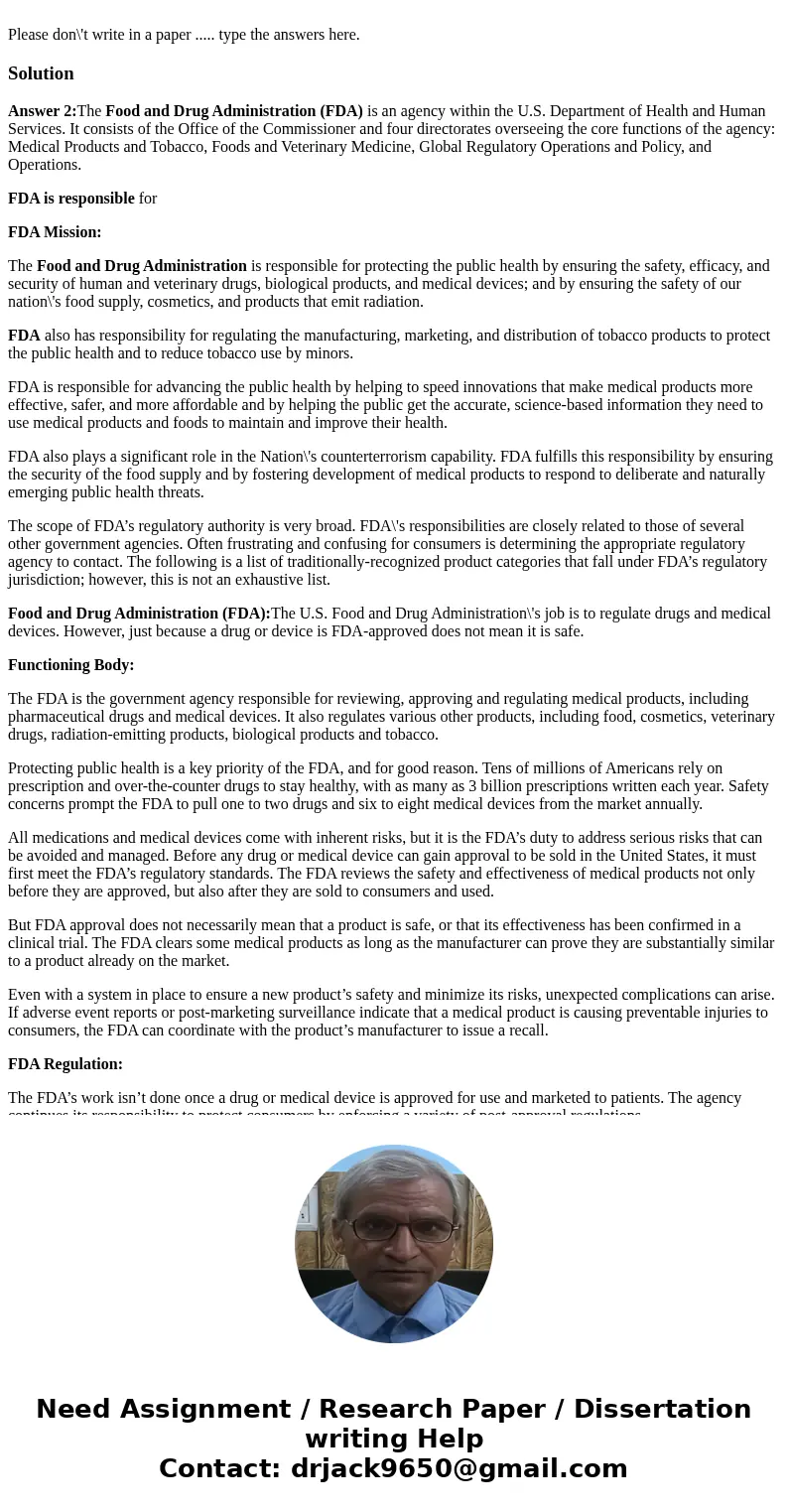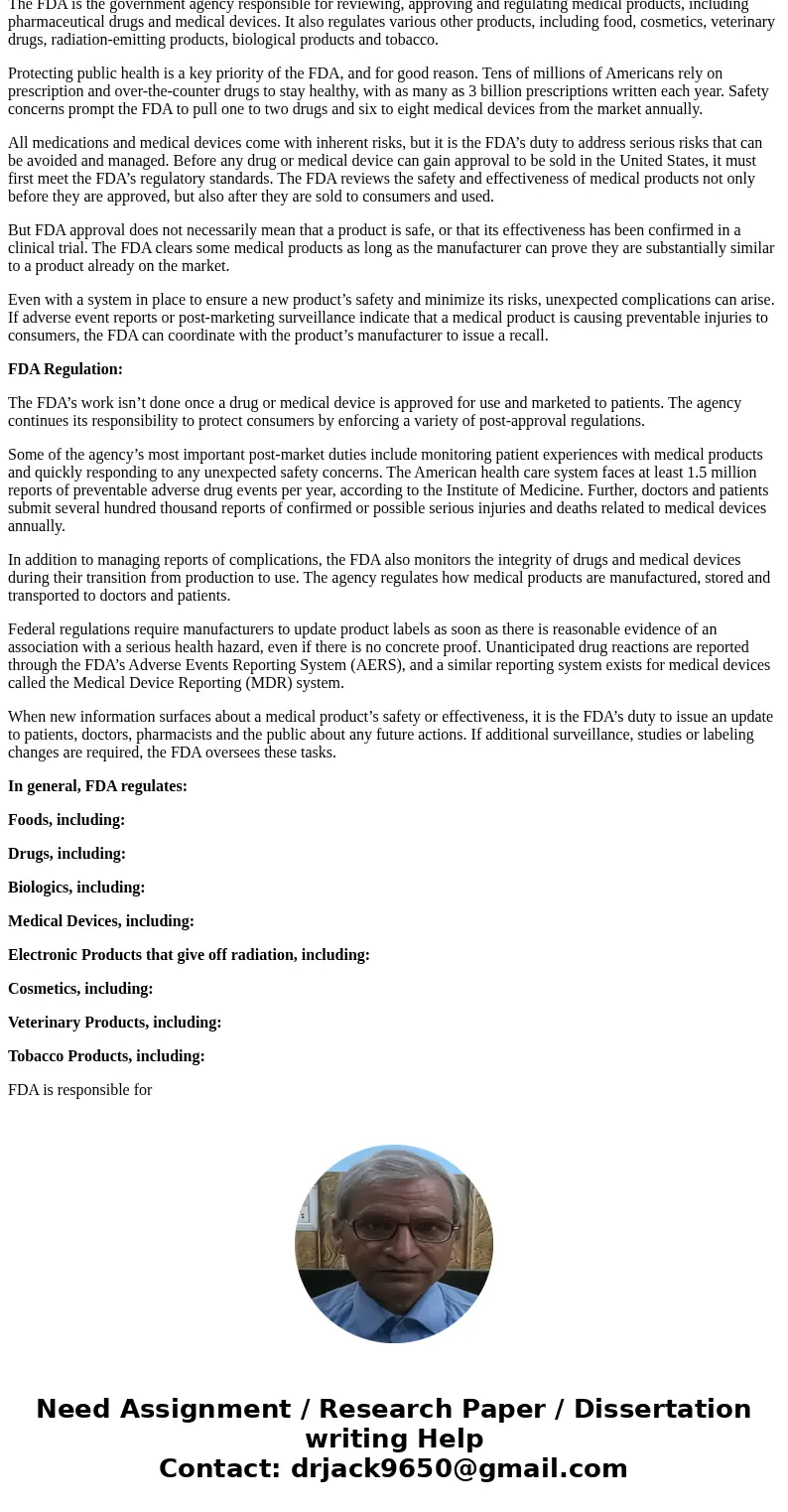Please dont write in a paper type the answers hereSolutionA
Solution
Answer 2:The Food and Drug Administration (FDA) is an agency within the U.S. Department of Health and Human Services. It consists of the Office of the Commissioner and four directorates overseeing the core functions of the agency: Medical Products and Tobacco, Foods and Veterinary Medicine, Global Regulatory Operations and Policy, and Operations.
FDA is responsible for
FDA Mission:
The Food and Drug Administration is responsible for protecting the public health by ensuring the safety, efficacy, and security of human and veterinary drugs, biological products, and medical devices; and by ensuring the safety of our nation\'s food supply, cosmetics, and products that emit radiation.
FDA also has responsibility for regulating the manufacturing, marketing, and distribution of tobacco products to protect the public health and to reduce tobacco use by minors.
FDA is responsible for advancing the public health by helping to speed innovations that make medical products more effective, safer, and more affordable and by helping the public get the accurate, science-based information they need to use medical products and foods to maintain and improve their health.
FDA also plays a significant role in the Nation\'s counterterrorism capability. FDA fulfills this responsibility by ensuring the security of the food supply and by fostering development of medical products to respond to deliberate and naturally emerging public health threats.
The scope of FDA’s regulatory authority is very broad. FDA\'s responsibilities are closely related to those of several other government agencies. Often frustrating and confusing for consumers is determining the appropriate regulatory agency to contact. The following is a list of traditionally-recognized product categories that fall under FDA’s regulatory jurisdiction; however, this is not an exhaustive list.
Food and Drug Administration (FDA):The U.S. Food and Drug Administration\'s job is to regulate drugs and medical devices. However, just because a drug or device is FDA-approved does not mean it is safe.
Functioning Body:
The FDA is the government agency responsible for reviewing, approving and regulating medical products, including pharmaceutical drugs and medical devices. It also regulates various other products, including food, cosmetics, veterinary drugs, radiation-emitting products, biological products and tobacco.
Protecting public health is a key priority of the FDA, and for good reason. Tens of millions of Americans rely on prescription and over-the-counter drugs to stay healthy, with as many as 3 billion prescriptions written each year. Safety concerns prompt the FDA to pull one to two drugs and six to eight medical devices from the market annually.
All medications and medical devices come with inherent risks, but it is the FDA’s duty to address serious risks that can be avoided and managed. Before any drug or medical device can gain approval to be sold in the United States, it must first meet the FDA’s regulatory standards. The FDA reviews the safety and effectiveness of medical products not only before they are approved, but also after they are sold to consumers and used.
But FDA approval does not necessarily mean that a product is safe, or that its effectiveness has been confirmed in a clinical trial. The FDA clears some medical products as long as the manufacturer can prove they are substantially similar to a product already on the market.
Even with a system in place to ensure a new product’s safety and minimize its risks, unexpected complications can arise. If adverse event reports or post-marketing surveillance indicate that a medical product is causing preventable injuries to consumers, the FDA can coordinate with the product’s manufacturer to issue a recall.
FDA Regulation:
The FDA’s work isn’t done once a drug or medical device is approved for use and marketed to patients. The agency continues its responsibility to protect consumers by enforcing a variety of post-approval regulations.
Some of the agency’s most important post-market duties include monitoring patient experiences with medical products and quickly responding to any unexpected safety concerns. The American health care system faces at least 1.5 million reports of preventable adverse drug events per year, according to the Institute of Medicine. Further, doctors and patients submit several hundred thousand reports of confirmed or possible serious injuries and deaths related to medical devices annually.
In addition to managing reports of complications, the FDA also monitors the integrity of drugs and medical devices during their transition from production to use. The agency regulates how medical products are manufactured, stored and transported to doctors and patients.
Federal regulations require manufacturers to update product labels as soon as there is reasonable evidence of an association with a serious health hazard, even if there is no concrete proof. Unanticipated drug reactions are reported through the FDA’s Adverse Events Reporting System (AERS), and a similar reporting system exists for medical devices called the Medical Device Reporting (MDR) system.
When new information surfaces about a medical product’s safety or effectiveness, it is the FDA’s duty to issue an update to patients, doctors, pharmacists and the public about any future actions. If additional surveillance, studies or labeling changes are required, the FDA oversees these tasks.
In general, FDA regulates:
Foods, including:
Drugs, including:
Biologics, including:
Medical Devices, including:
Electronic Products that give off radiation, including:
Cosmetics, including:
Veterinary Products, including:
Tobacco Products, including:
FDA is responsible for


 Homework Sourse
Homework Sourse